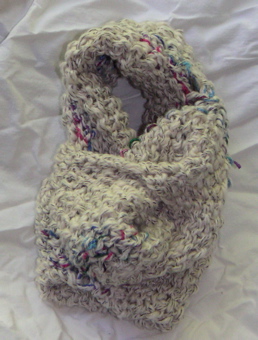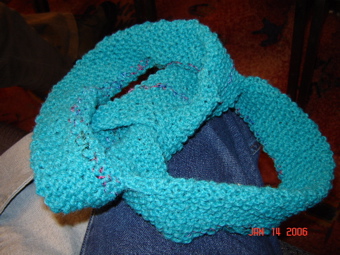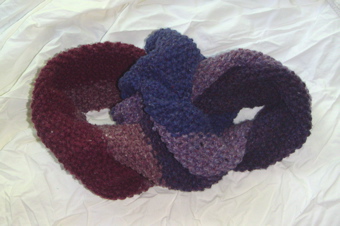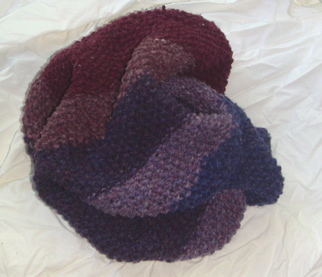
...has genus 3. It's knitted somewhat sloppily (hey, it was my first attempt) with the colored
bits corresponding to the three homotopy generators.
This page is devoted to knitted nonorientable surfaces of higher genus than two. For Möbius bands, projective planes, and Klein bottles, see my other pages (as linked). I also have a page on orientable surfaces.
While the surfaces on this page used more than one piece of yarn (in order to accomplish the color changes), each could have been knitted from a single strand. Well, okay, the ball of yarn would have had to be topological---I might have needed to shrink it in order to shove it through some stitches every now and then---but mathematically speaking, each could have been knitted from a single strand.
Every nonorientable surface is equivalent to the connected sum of some number of projective planes; that number is called the genus of the surface. A projective plane (P) has genus 1, a Klein bottle (P#P) has genus 2, and this...

...has genus 3. It's knitted somewhat sloppily (hey, it was my first attempt) with the colored
bits corresponding to the three homotopy generators.
Here is a genus-4 surface
(photo taken by Bob Vallin at the 2006 JMM). Again, colored bits correspond
to homotopy generators.
Here is a nonorientable surface of genus 5... each color corresponds to a
different projective plane.

A paper describing general methods for knitting these surfaces appears in the Journal of Mathematics and the Arts. (Citation: Every Topological Surface Can Be Knit: A Proof, Journal of Mathematics and the Arts, 3(2) June 2009, 67–83.) Knitting patterns will eventually appear... somewhere, probably in a book.
There are public  pages for some of my other nonorientable surfaces:
pages for some of my other nonorientable surfaces:
four
surfaces from one skein of yarn
connected sum of 3 projective planes (P#P#P)
a striped P#P#P